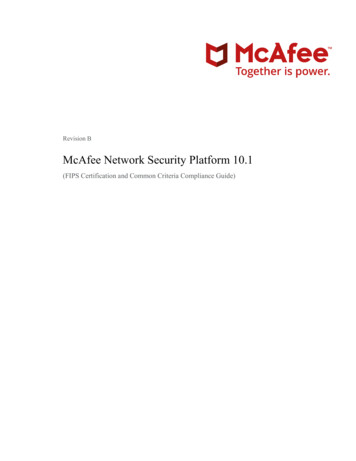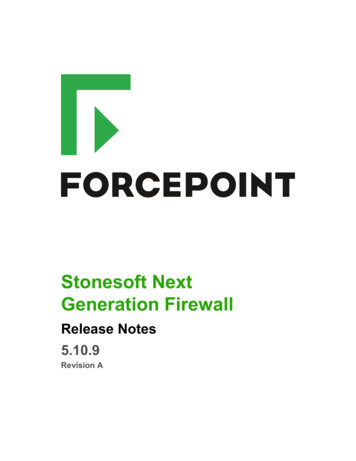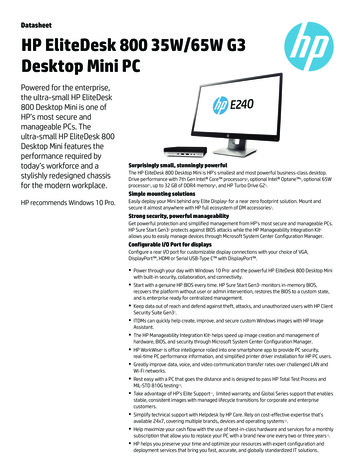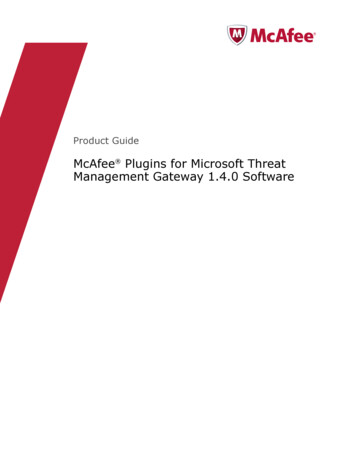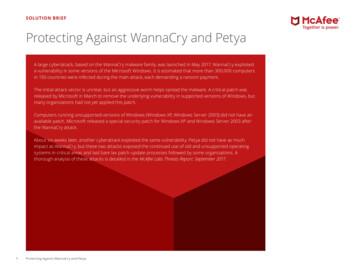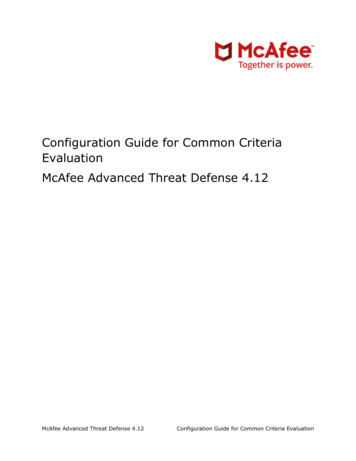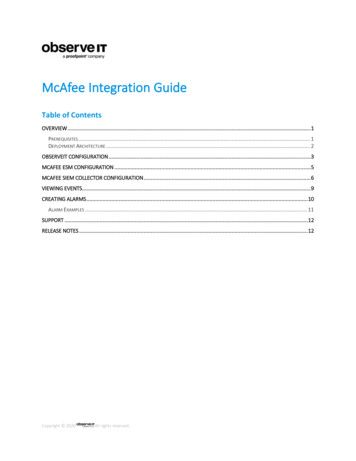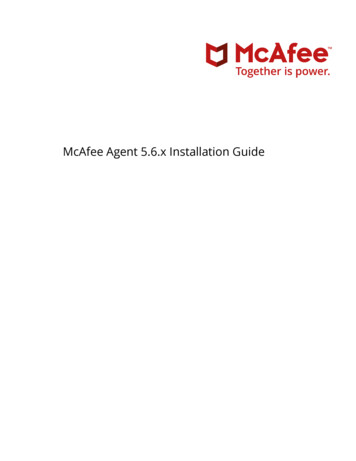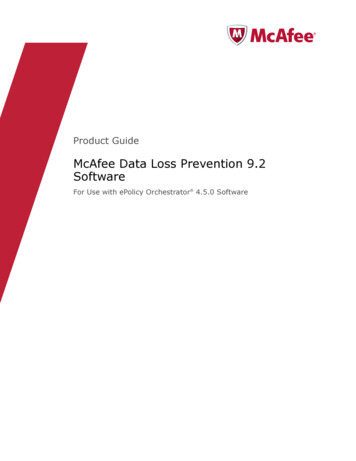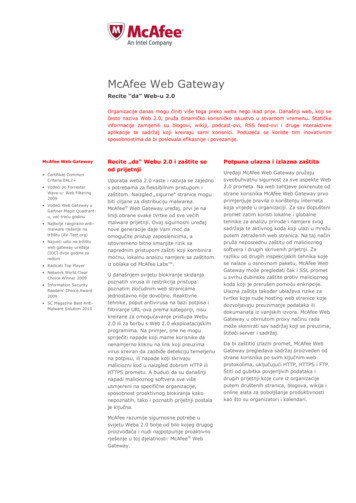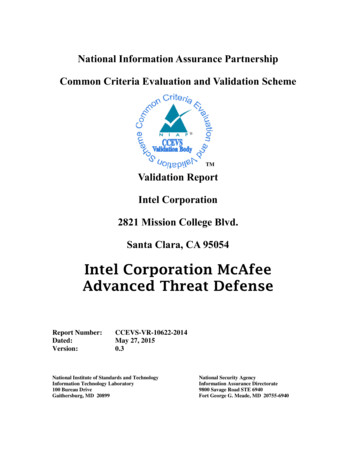
Transcription
National Information Assurance PartnershipCommon Criteria Evaluation and Validation Scheme TMValidation ReportIntel Corporation2821 Mission College Blvd.Santa Clara, CA 95054Intel Corporation McAfeeAdvanced Threat DefenseReport Number:Dated:Version:CCEVS-VR-10622-2014May 27, 20150.3National Institute of Standards and TechnologyInformation Technology Laboratory100 Bureau DriveGaithersburg, MD 20899National Security AgencyInformation Assurance Directorate9800 Savage Road STE 6940Fort George G. Meade, MD 20755-6940
Intel MATDValidation Report, Version 0.3May 27, 2015ACKNOWLEDGEMENTSValidation TeamCommon Criteria Testing LaboratoryTammy ComptonChris KeenanGossamer Security Solutions, Inc.Catonsville, MDii
Intel MATDValidation Report, Version 0.3May 27, 2015Table of Contents123Executive Summary . 1Identification . 2Architectural Information . 33.1TOE Evaluated Platforms . 33.2Physical Boundaries . 34 Security Policy . 44.1Security audit . 44.2Cryptographic support . 44.3User data protection . 44.4Identification and authentication. 54.5Security management . 54.6Protection of the TSF . 54.7TOE access. 54.8Trusted path/channels . 55 Assumptions. 56 Documentation . 57 IT Product Testing . 67.1Developer Testing . 67.2Evaluation Team Independent Testing . 68 Evaluated Configuration . 69 Results of the Evaluation . 69.1Evaluation of the Security Target (ASE) . 79.2Evaluation of the Development (ADV) . 79.3Evaluation of the Guidance Documents (AGD) . 79.4Evaluation of the Life Cycle Support Activities (ALC) . 79.5Evaluation of the Test Documentation and the Test Activity (ATE) . 89.6Vulnerability Assessment Activity (VAN) . 89.7Summary of Evaluation Results. 810 Validator Comments/Recommendations . 811 Annexes. 812 Security Target . 813 Glossary . 914 Bibliography . 9iii
Intel MATDValidation Report, Version 0.3May 27, 20151 Executive SummaryThis report documents the assessment of the National Information Assurance Partnership(NIAP) validation team of the evaluation of McAfee Advanced Threat Defense solutionprovided by Intel Corporation. It presents the evaluation results, their justifications, andthe conformance results. This Validation Report is not an endorsement of the Target ofEvaluation by any agency of the U.S. government, and no warranty is either expressed orimplied.The evaluation was performed by the Gossamer Security Solutions (Gossamer) CommonCriteria Testing Laboratory (CCTL) in Catonsville, MD, United States of America, andwas completed in May 2015. The information in this report is largely derived from theEvaluation Technical Report (ETR) and associated test reports, all written by GossamerSecurity Solutions. The evaluation determined that the product is both Common CriteriaPart 2 Extended and Part 3 Conformant, and meets the assurance requirements of EAL 1.The Target of Evaluation (TOE) is the McAfee Advanced Threat Defense models 3000 and6000 running software version 3.4.6 products. The TOE is a hardware network appliance.The product provides a web interface over TLS and a console connection.The Target of Evaluation (TOE) identified in this Validation Report has been evaluated at aNIAP approved Common Criteria Testing Laboratory using the Common Methodology forIT Security Evaluation (Version 3.1, Rev 4) for conformance to the Common Criteria forIT Security Evaluation (Version 3.1, Rev 4). This Validation Report applies only to thespecific version of the TOE as evaluated. The evaluation has been conducted inaccordance with the provisions of the NIAP Common Criteria Evaluation and ValidationScheme and the conclusions of the testing laboratory in the evaluation technical report areconsistent with the evidence provided.The validation team monitored the activities of the evaluation team, provided guidance ontechnical issues and evaluation processes, and reviewed the individual work units andsuccessive versions of the ETR. The validation team found that the evaluation showed thatthe product satisfies all of the functional requirements and assurance requirements stated inthe Security Target (ST). Therefore the validation team concludes that the testinglaboratory’s findings are accurate, the conclusions justified, and the conformance resultsare correct. The conclusions of the testing laboratory in the evaluation technical report areconsistent with the evidence produced.The Gossamer Security Solutions evaluation team concluded that the Common Criteriarequirements for Evaluation Assurance Level (EAL) 1.The technical information included in this report was obtained from the – Intel CorporationMcAfee Advanced Threat Defense (NDPP11e3) Security Target and analysis performed bythe Validation Team.1
Intel MATDValidation Report, Version 0.3May 27, 20152 IdentificationThe CCEVS is a joint National Security Agency (NSA) and National Institute of Standardseffort to establish commercial facilities to perform trusted product evaluations. Under thisprogram, security evaluations are conducted by commercial testing laboratories calledCommon Criteria Testing Laboratories (CCTLs) using the Common EvaluationMethodology (CEM) for Evaluation Assurance Level (EAL) 1 through 4 in accordancewith National Voluntary Laboratory Assessment Program (NVLAP) accreditation.The NIAP Validation Body assigns Validators to monitor the CCTLs to ensure quality andconsistency across evaluations. Developers of information technology products desiring asecurity evaluation contract with a CCTL and pay a fee for their product’s evaluation.Upon successful completion of the evaluation, the product is added to NIAP’s ValidatedProducts List.Table 1 provides information needed to completely identify the product, including: The Target of Evaluation (TOE): the fully qualified identifier of the product asevaluated. The Security Target (ST), describing the security features, claims, and assurances of theproduct. The conformance result of the evaluation. The Protection Profile to which the product is conformant. The organizations and individuals participating in the evaluation.Table 1: Evaluation IdentifiersItemIdentifierEvaluation SchemeUnited States NIAP Common Criteria Evaluation and Validation SchemeTOE:Intel Corporation McAfee Advanced Threat Defense models 3000 and 6000running software version 3.4.6Protection ProfileProtection Profile for Network Devices, version 1.1, 8 June 2012 (NDPP)(including the optional TLS requirements) with Errata #3ST:Intel Corporation McAfee Advanced Threat Defense (NDPP11e3) SecurityTarget, Version 0.5, May 22, 2015Evaluation TechnicalReportEvaluation Technical Report for McAfee Advanced Threat Defense (NDPP11e3),Version 0.3, May 27, 2015CC VersionCommon Criteria for Information Technology Security Evaluation, Version 3.1,rev 4Conformance ResultCC Part 2 extended, CC Part 3 conformantSponsorIntel CorporationDeveloperIntel Corporation2
Intel MATDValidation Report, Version 0.3May 27, 2015ItemIdentifierCommon CriteriaTesting Lab (CCTL)Gossamer Security Solutions, Inc.CCEVS Validators3 Architectural InformationNote: The following architectural description is based on the description presented in theSecurity Target.The Target of Evaluation (TOE) is Error! Reference source not found. (MATD). MATDdetects today’s stealthy, zero-day malware with layered approach. It combines low-touchantivirus signatures, reputation, and real-time emulation defenses with in-depth static codeand dynamic analysis (sandboxing) to analyze actual behavior.The MATD hardware appliance implements dynamic and statistical analysis on datatransmitted through a network to provide malware detection, assessment and classification.The MATD processes the files through the down selectors for statistical analysis andprovides a sandbox test environment which includes virtual machines running customerenvironments, anti-virus, anti-malware, local blacklist and whitelists. Files are executedwithin virtual machine environments that are monitored by the log file. The log file is thenused to generate a security report of the potential malware.For the purpose of evaluation, MATD will be treated as a network device offering CAVPcertified cryptographic functions, security auditing, secure administration, trusted updates,self-tests, and secure connections to other servers (e.g., to transmit audit records)3.1 TOE Evaluated PlatformsThe evaluated configuration of consists of McAfee Advanced Threat Defense withsoftware version 3.4.6 running on one of the following modules: ATD-6000: McAfee Advanced Threat Defense 6000 ATD-3000: McAfee Advanced Treat Defense 30003.2 Physical BoundariesThe ATD evaluated configuration includes software version 3.4.6 running on one of thefollowing modules:3
Intel MATDValidation Report, Version 0.3May 27, 2015 ATD-6000: McAfee Advanced Threat Defense 6000, 2U 4x Xeon E5-4640(2.5GHz), 256GB DDR3, 16TB of HDD storage and 1600MB of SSD storage. ATD-3000: McAfee Advanced Treat Defense 3000, 1U 2x Xeon E5-2658(2.1GHz), 192GB DDR3, 8TB of HDD storage and 800MB of SSD storageThe TOE may be accessed and managed through a PC or terminal in the environmentwhich can be remote from or directly connected to the TOE.The TOE can be configured to forward its audit records to an external syslog server in thenetwork environment. This is generally advisable given the limited audit log storage spaceon the evaluated appliances.The TOE can be configured to synchronize its internal clock using an external NTP serverin the operational environment.4 Security PolicyThis section summaries the security functionality of the TOE:1. Security audit2. Cryptographic support3. User data protection4. Identification and authentication5. Security Management6. Protection of the TSF7. TOE access8. Trusted path/channels4.1 Security auditThe TOE generates audit events associated with identification and authentication,management, updates, and user sessions. The TOE can store the events in a local log orexport them to a syslog server using a TLS protected channel.4.2 Cryptographic supportThe TOE provides CAVP certified cryptography in support of its TLS implementation.Cryptographic services include key management, random bit generation,encryption/decryption, digital signature and secure hashing.4.3 User data protectionThe TOE ensures that residual information is protected from potential reuse in accessibleobjects such as network packets4
Intel MATDValidation Report, Version 0.3May 27, 20154.4 Identification and authenticationThe TOE requires users to be identified and authenticated before they can use functionsmediated by the TOE, with the exception of reading the login banner. It provides theability to both assign attributes (user names, passwords and roles) and to authenticate usersagainst these attributes.4.5 Security managementThe TOE provides a command line (CLI) management interface as well as a graphical userinterface (GUI) accessed via the web. The web interface is protected with TLS. Themanagement interface is limited to the authorized administrator (as defined by a role).4.6 Protection of the TSFThe TOE provides a variety of means of protecting itself. The TOE performs self-tests thatcover the correct operation of the TOE. It provides functions necessary to securely updatethe TOE. It provides a hardware clock to ensure reliable timestamps. It protects sensitivedata such as stored passwords and cryptographic keys so that they are not accessible evenby an authorized administrator.4.7 TOE accessThe TOE can be configured to display a logon banner before a user session is established.The TOE also enforces inactivity timeouts for local and remote sessions.4.8 Trusted path/channelsThe TOE provides a local console which is subject to physical protection. For remoteaccess, the web GUI is protected by TLS thus ensuring protection against modification anddisclosure.The TOE also protects its audit records from modification and disclosure by using TLS tocommunicate with the syslog server.5 AssumptionsThe Security Problem Definition, including the assumptions, may be found in theProtection Profile for Network Devices, version 1.1, 8 June 2012 (NDPP). Thatinformation has not been reproduced here and the NDPP should be consulted if there isinterest in that material.6 DocumentationThe following documents were available with the TOE for evaluation:5
Intel MATDValidation Report, Version 0.3May 27, 2015 NDPP Admin Guide, v 3.4.6, 5/20/15 ATD 3.4.6 Product Guide, Revision A7 IT Product TestingThis section describes the testing efforts of the developer and the Evaluation Team. It isderived from information contained in the Evaluation Team Test Report for the McAfeeAdvanced Threat Defense, Version 1.3, May 25, 2015.7.1 Developer TestingNo evidence of developer testing is required in the assurance activities for this product.7.2 Evaluation Team Independent TestingThe evaluation team verified the product according the NDPP Admin Guide, v 3.4.6,5/20/15 document and ran the tests specified in the NDPP including the optional TLS tests.8 Evaluated ConfigurationThe evaluated configuration, as defined in the Security Target, consists of McAfeeAdvanced Threat Defense with software version 3.4.6 running on one of the followingmodules: ATD-6000: McAfee Advanced Threat Defense 6000, 2U 4x Xeon E5-4640(2.5GHz), 256GB DDR3, 16TB of HDD storage and 1600MB of SSD storage. ATD-3000: McAfee Advanced Treat Defense 3000, 1U 2x Xeon E5-2658(2.1GHz), 192GB DDR3, 8TB of HDD storage and 800MB of SSD storageTo use the product in the evaluated configuration, the product must be configured asspecified in the NDPP Admin Guide, v 3.4.6, 5/20/15 document.9 Results of the EvaluationThe results of the assurance requirements are generally described in this section and arepresented in detail in the proprietary ETR. The reader of this document can assume that allEAL1 work units received a passing verdict.A verdict for an assurance component is determined by the resulting verdicts assigned tothe corresponding evaluator action elements. The evaluation was conducted based upon6
Intel MATDValidation Report, Version 0.3May 27, 2015CC version 3.1 rev 4 and CEM version 3.1 rev 4. The evaluation determined the ProductName TOE to be Part 2 extended, and to meet the Part 3 Evaluation Assurance Level (EAL1).9.1 Evaluation of the Security Target (ASE)The evaluation team applied each ASE CEM work unit. The ST evaluation ensured the STcontains a description of the environment in terms of policies and assumptions, a statementof security requirements claimed to be met by the Error! Reference source not found.models 3000 and 6000 running software version 3.4.6 products that are consistent with theCommon Criteria, and product security function descriptions that support the requirements.The validator reviewed the work of the evaluation team, and found that sufficient evidenceand justification was provided by the evaluation team to confirm that the evaluation wasconducted in accordance with the requirements of the CEM, and that the conclusionreached by the evaluation team was justified.9.2 Evaluation of the Development (ADV)The evaluation team applied each EAL 1 ADV CEM work unit. The evaluation teamassessed the design documentation and found it adequate to aid in understanding how theTSF provides the security functions. The design documentation consists of a functionalspecification contained in the Security target and Guidance documents. Additionally theevaluator performed the assurance activities specified in the NDPP related to theexamination of the information contained in the TSS.The validator reviewed the work of the evaluation team, and found that sufficient evidenceand justification was provided by the evaluation team to confirm that the evaluation wasconducted in accordance with the requirements of the CEM, and that the conclusionreached by the evaluation team was justified.9.3 Evaluation of the Guidance Documents (AGD)The evaluation team applied each EAL 1 AGD CEM work unit. The evaluation teamensured the adequacy of the user guidance in describing how to use the operational TOE.Additionally, the evaluation team ensured the adequacy of the administrator guidance indescribing how to securely administer the TOE. All of the guides were assessed during thedesign and testing phases of the evaluation to ensure they were complete.The validator reviewed the work of the evaluation team, and found that sufficient evidenceand justification was provided by the evaluation team to confirm that the evaluation wasconducted in accordance with the requirements of the CEM, and that the conclusionreached by the evaluation team was justified.9.4 Evaluation of the Life Cycle Support Activities (ALC)The evaluation team applied each EAL 1 ALC CEM work unit. The evaluation team foundthat the TOE was identified.The validator reviewed the work of the evaluation team, and found that sufficient evidenceand justification was provided by the evaluation team to confirm that the evaluation was7
Intel MATDValidation Report, Version 0.3May 27, 2015conducted in accordance with the requirements of the CEM, and that the conclusionreached by the evaluation team was justified.9.5 Evaluation of the Test Documentation and the Test Activity (ATE)The evaluation team applied each EAL 1 ATE CEM work unit. The evaluation team ranthe set of tests specified by the assurance activities in the NDPP and recorded the results ina Test Report, summarized in the Assurance Activities Report.The validator reviewed the work of the evaluation team, and found that sufficient evidenceand justification was provided by the evaluation team to confirm that the evaluation wasconducted in accordance with the requirements of the CEM, and that the conclusionreached by the evaluation team was justified.9.6 Vulnerability Assessment Activity (VAN)The evaluation team applied each EAL 1 AVA CEM work unit. The evaluation teamperformed a public search for vulnerabilities and did not discover any public issues withthe TOE.The validator reviewed the work of the evaluation team, and found that sufficient evidenceand justification was provided by the evaluation team to confirm that the evaluation wasconducted in accordance with the requirements of the CEM, and that the conclusionreached by the evaluation team was justified.9.7 Summary of Evaluation ResultsThe evaluation team’s assessment of the evaluation evidence demonstrates that the claimsin the ST are met. Additionally, the evaluation team’s testing also demonstrated theaccuracy of the claims in the ST.The validation team’s assessment of the evidence provided by the evaluation team is that itdemonstrates that the evaluation team followed the procedures defined in the CEM, andcorrectly verified that the product meets the claims in the ST.10 Validator Comments/RecommendationsThis section is used to impart additional information about the evaluation results. Thesecomments/ recommendations can take the form of shortcomings of the IT productdiscovered during the evaluation or mention of features which are particularly useful.11 AnnexesNot applicable12 Security TargetThe Security Target is identified as Intel Corporation McAfee Advanced Threat Defense(NDPP11e3) Security Target, Version 0.5, May 22, 2015.8
Intel MATDValidation Report, Version 0.3May 27, 201513 GlossaryThe following definitions are used throughout this document: Common Criteria Testing Laboratory (CCTL). An IT security evaluation facilityaccredited by the National Voluntary Laboratory Accreditation Program (NVLAP) andapproved by the CCEVS Validation Body to conduct Common Criteria-basedevaluations. Conformance. The ability to demonstrate in an unambiguous way that a givenimplementation is correct with respect to the formal model. Evaluation. The assessment of an IT product against the Common Criteria using theCommon Criteria Evaluation Methodology to determine whether or not the claimsmade are justified; or the assessment of a protection profile against the CommonCriteria using the Common Evaluation Methodology to determine if the Profile iscomplete, consistent, technically sound and hence suitable for use as a statement ofrequirements for one or more TOEs that may be evaluated. Evaluation Evidence. Any tangible resource (information) required from the sponsoror developer by the evaluator to perform one or more evaluation activities. Feature. Part of a product that is either included with the product or can be orderedseparately. Target of Evaluation (TOE). A group of IT products configured as an IT system, oran IT product, and associated documentation that is the subject of a security evaluationunder the CC. Validation. The process carried out by the CCEVS Validation Body leading to theissue of a Common Criteria certificate. Validation Body. A governmental organization responsible for carrying out validationand for overseeing the day-to-day operation of the NIAP Common Criteria Evaluationand Validation Scheme.14 BibliographyThe Validation Team used the following documents to produce this Validation Report:[1]Common Criteria for Information Technology Security Evaluation: Part 1:Introduction and General Model, Version 3.1, Revision 4, September 2012.[2]Common Criteria for Information Technology Security Evaluation Part 2: Securityfunctional components, Version 3.1, Revision 4, September 2012.[3]Common Criteria for Information Technology Security Evaluation Part 3: Securityassurance components, Version 3.1 Revision 4, September 2102.[4]Protection Profile for Network Devices, version 1.1, 8 June 2012 (NDPP).9
ATD-6000: McAfee Advanced Threat Defense 6000, 2U 4x Xeon E5-4640 (2.5GHz), 256GB DDR3, 16TB of HDD storage and 1600MB of SSD storage. ATD-3000: McAfee Advanced Treat Defense 3000, 1U 2x Xeon E5-2658 (2.1GHz), 192GB DDR3, 8TB of HDD storage and 800MB of SSD storage
